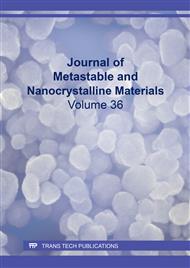[1]
Ghada E. Dawwam, Mona Al-Shemy, Azza S El-Demerdash, Green synthesis of cellulose nanocrystal/ ZnO bio-nanocomposites exerting antibacterial activity and downregulating virulence toxigenic genes of food-poisoning bacteria, Scientific Reports. 12 (2022)16848.
DOI: 10.1038/s41598-022-21087-6
Google Scholar
[2]
Kieush Lina, Svietkina Olena, Koveria Andrii, Sustainable development of resource-saving technologies in mineral mining and processing, Nanomaterials in the drilling fluids for oil and gas production: Universitas Publishing Petrosani multi-authored monograph a review (2019) 307.
Google Scholar
[3]
Xu Liu, Yang Wang, Zheng Cheng, Jie Sheng, Rendang Yang, Nano-sized fibrils dispersed from bacterial cellulose grafted with chitosan, J. Carbohydrate Polymers. Volume 214 (2019) 311-316.
DOI: 10.1016/j.carbpol.2019.03.055
Google Scholar
[4]
Surafel MB, Temesgen AA, S. Venkatesa P, Abraham GA, Production of nanocellulose crystal derived from inset fiber using acid hydrolysis coupled with ultrasonication, isolation, statistical modeling, optimization, and characterizations, Hindawi Journal of Nanomaterials (2021).
DOI: 10.1155/2021/7492532
Google Scholar
[5]
Maimunah A, Dzun NJ, Nur HZJ, Wan MFWN, Nor FMA, Mohd FAW, Entangled cellulose nanofibers produced from sugarcane bagasse via alkaline treatment, and mild acid hydrolysis assisted with ultrasonication, Journal of King Saud University-Engineering Sciences (2021).
DOI: 10.1016/j.jksues.2021.03.003
Google Scholar
[6]
Dilhun KA-Ucar, Figen K, Lin SL, Kit L Yam, Characterization of bacterial cellulose nanocrystal: effect of acid treatments and neutralization, Food chemistry. Volume 336 (2021).
Google Scholar
[7]
Edy Yafri, Jamaludin, Nasmi H Sari, Melbi Mahardika, Putri Amanda, Rushdan Ahmadllyas, Isolation and characterization of cellulose nanofibers from agave gigantea by chemical-mechanical treatment, Journal of biological macromolecular. Volume 200 (2022) pages 25-33.
DOI: 10.1016/j.ijbiomac.2021.12.111
Google Scholar
[8]
Sofla MRK, Brown RJ, Suzuki TT, Rainey TJ, A comparison of cellulose nanocrystals and cellulose nanofibers extracted from bagasse using acid and ball milling methods, Advances in Natural Sciences: nanosciences and nanotechnology. 7 (2016) 035004.
DOI: 10.1088/2043-6262/7/3/035004
Google Scholar
[9]
Miao C, Hamad WY, Critical insights into the reinforcement potential of cellulose nanocrystals in polymer nanocomposites, Current Opinion in solid state & Materials Science. J homepage.
DOI: 10.1016/j.cossms.2019.06.005
Google Scholar
[10]
Rattaz A, Mishra SP, Chabot B, Daneault C, Cellulose nanofibres by sonocatalized-TEMPO-oxidation.) J Cellulose. 18 (2011) 585-593.
DOI: 10.1007/s10570-011-9529-8
Google Scholar
[11]
Ioelovich M, Optimal conditions for isolation of nanocrystalline cellulose particles, Nanosci Nanotechnol. 2 ((2012) 9–13.
Google Scholar
[12]
Johar N, Ahmad I, Dufresne A, Extraction, preparation, and characterization of cellulose fibers and nanocrystals from rice husk, Ind. Crops Prod. 37 (2012) 93-99.
DOI: 10.1016/j.indcrop.2011.12.016
Google Scholar
[13]
Neto ETT, Guilherme MR, Tenorio MKL, Scariot DB, Nakamura CV, Rubira AF, Kunita MH, Synthesis and characterization of a pH-responsive poly(ethylene glycol)-based hydrogel: acid degradation, equilibrium swelling, and absorption kinetic characteristics, Colloid Polym Sci. (2015).
DOI: 10.1007/s00396-015-3744-z
Google Scholar
[14]
Silvério HA, Neto WPF, Dantas NO, Pasquini D, Extraction and characterization of cellulose nanocrystals from corncob for application as reinforcing agent in nanocomposites, Ind. Crops Prod. 44 (2013b) 427-436.
DOI: 10.1016/j.indcrop.2012.10.014
Google Scholar
[15]
Santos RMd, Neto WPF, Silverio Khawas P, Sankar CD, Isolation and characterization of cellulose nanofibers from culinary banana peel using high-intensity ultrasonication combined with chemical treatment, Carbohydrate Polymers. 137 (2016) 608-616.
DOI: 10.1016/j.carbpol.2015.11.020
Google Scholar
[16]
Khashayar V, Ghasem A, Seyed HS, Bio nanocomposites based on cationic starch reinforced with montmorillonite and cellulose nanocrystals: fundamental properties and biodegradability study, J. Biological macromolecules. 146 (2020) 374-386.
DOI: 10.1016/j.ijbiomac.2020.01.007
Google Scholar
[17]
Narsimha Pandi, Shirish H. Sonawane, K. Anand Kishore, Synthesis of cellulose nanocrystals (CNCs) from cotton using ultrasound-assisted acid hydrolysis, J. Ultrasonics Sonochemistry. volume 70 (2021).
DOI: 10.1016/j.ultsonch.2020.105353
Google Scholar
[18]
Rosa MF, Medeiros ES, Malmonged JA, Gregorsk KS, Wood DF, Mattoso LCH, Glenn G, Orts WJ, Imam SH, Cellulose nanowhiskers from coconut husk fibers: Effect of preparation conditions on their thermal and morphological behavior, Carbohydrate Polymers. 81 (2010) 283-92.
DOI: 10.1016/j.carbpol.2010.01.059
Google Scholar
[19]
Vasconcelos Niedja F, Feitosa Judith PA, Gama Francisco MP, Morais Joao PS, Andrade Fabia K, Filho Men de Sa MS, Rosa Morsyleide S, Bacterial cellulose nanocrystals produced under different hydrolysis conditions: Properties and morphological feature, Carbohydrate Polymers 155 (2017) 425-431.
DOI: 10.1016/j.carbpol.2016.08.090
Google Scholar
[20]
Halib N, Amin MCIM, Physicochemical properties and characterization of nata de coco from local food industries as of cellulose, Sains Malaysia 41 (2012) 205- 211.
Google Scholar
[21]
Hassan SSM, Azab WIMEI, Ali HR, Mansour MSM, Green synthesis and characterization of ZnO nanoparticles for photocatalytic degradation of anthracene, Advances in natural sciences: nanoscience and nanotechnology 6 (2015) 045012.
DOI: 10.1088/2043-6262/6/4/045012
Google Scholar
[22]
Isabela Reiniati, Hrymak Andrew N, Margariti Argyrios, Recent developments in the production and applications of bacterial cellulose fibers and nanocrystals, Critical reviews in biotechnology. Volume 37 (2017) 510-524, Taylor & Francis.
DOI: 10.1080/07388551.2016.1189871
Google Scholar
[23]
L Pedreros, F Cardenas, N Ramirez, E Forero, LNDT Non-Destructive test for quality evaluation of concrete specimens by ultrasonic. Pulse velocity measurement. Materials science and engineering 844 (2020) 012041.
DOI: 10.1088/1757-899x/844/1/012041
Google Scholar


